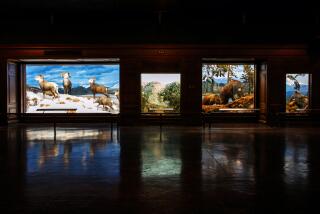Are These Displays Animal or Art?
- Share via
Adolf Seilacher was working his way through an unusual exhibit at the Peabody Museum of Natural History in New Haven, Conn., when he stopped in front of something labeled “Shrimp Burrow Jungle.”
It was a product of science, but there was no scientific name, only the fanciful title and a gracefully textured, upright, 7-foot-by-3-foot cast image of ancient sediments.
On display was a tangle of interlocking tunnels left in the sea floor hundreds of millions of years ago by an early form of shrimp. For scientists like Seilacher, those sediments help explain the development of life on Earth.
But the science would wait.
“Try to look at these things with an unprejudiced eye,” Seilacher said. “Just be impressed, be fascinated by these things like you are when looking at a piece of art.”
Indeed, the Yale University museum’s new exhibit is titled “Fossil Art.” Casts of dozens of fossils from throughout the world are on display, most of them more than 6 feet high and several feet wide, each of them telling a story in sediment.
Seilacher, an internationally renowned paleontologist, believes these casts are striking enough to connect the abstract world of art to the just-the-facts discipline of science. Moved by the fossils’ beauty, people will want to know the science behind them.
“What we experience ourselves as scientists is first the discovery,” he said. “And the discovery is a fascination by something. We say, ‘Ahhh.’ So your first reaction is emotional, emotional in the sense that you are touched by a piece of art or a very good photograph.
“Only then we say, ‘OK, what is the reason for it?’ Then comes the analysis. I hope the visitors do this in looking at these things first, then also read the catalog and say, ‘This is why.’ ”
The 64-page exhibit catalog includes detailed information on each of the casts.
So interesting are these cast images that they almost overshadow what otherwise is the star of the exhibit--a newly discovered fossil of what may be the oldest known animal, a worm-like creature that may have lived more than 1 billion years ago.
The casts, because of their large scale and the minute detail that modern casting technology allows, seize a viewer’s attention and reward scrutiny.
A cast called “Lasso Trail,” for example, appears at first glance to be lyrical rope-like coils laid upon rock in painterly fashion. Within the coils, helping create the impression of rope texture, is an undulating, sharply etched pattern.
Seilacher explained how the “lasso” was created. It was, again, the tunnel of an ancient creature moving through sediment.
The undulating pattern within the lasso was forged by a primitive snorkel that poked through the sediment surface. As the animal moved, its snorkel swayed to and fro, etching what today is a scientific still life.
But is this--the preserved path of an animal--art?
“It depends on how you define art,” said Richard Benson, dean of the Yale School of Art. “I think the material in the show is extremely interesting and very, very beautiful. I think you really can’t say whether it is art or not unless you it down and decide what is art.”
If art is something creative that people make--the common definition--then fossils are not art. But these are cast images of the fossils, displayed as much for their beauty as for their scientific significance.
If a photograph of a landscape can be art, Seilacher said, then why not an image of a fossil?
Stephen J. Gould, the Harvard paleontologist and author, said the exhibit “has broken new ground, both aesthetically and intellectually.” In presentations of fossils as art, the fossil of a creature is the art, he said, while in Seilacher’s exhibit most of the casts represent the behavior of animals.
“Thus we learn that organic effort can be as beautiful as organic form,” he wrote in the catalog.
In a departure from convention in natural history museums, visitors will be able to touch this evidence of earliest life on Earth.
“Yes, if they just gently touch it,” Seilacher said. It’s not just a piece of rock, after all. It’s art.


